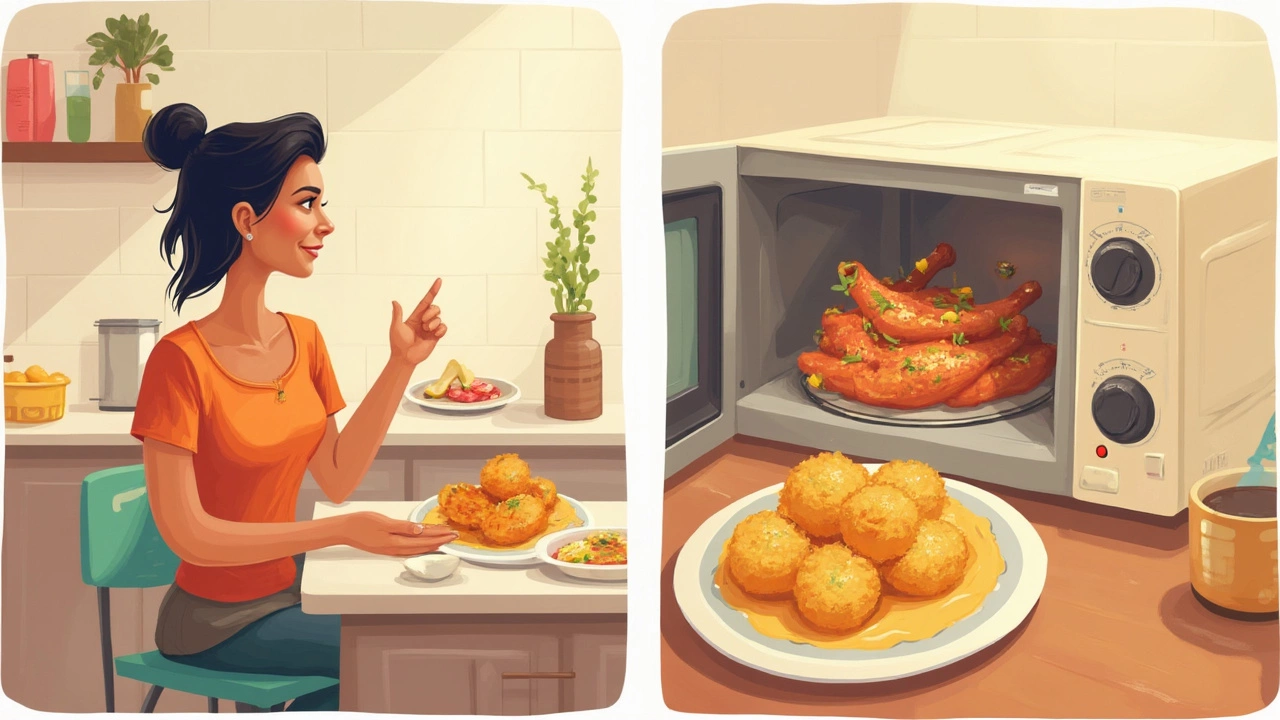
Most people grab a microwave to zap leftovers, but you’re actually missing out if that’s all you’re using it for. Want a fresh cup of coffee heated in under a minute? Or a batch of popcorn that’s hot and fluffy without babysitting the stove? The microwave’s got you covered on busy days.
You don’t need to know much about cooking to use a microwave well, either. Just toss in your plate, set the timer, and you’re good. But here’s where it gets interesting—certain foods actually turn out better in a microwave, like steamed veggies or quick mug cakes. You can even pull off scrambled eggs in a mug and they won’t stick or dry out like in a pan.
So, if you think your microwave is just for soggy pizza, you’re selling yourself short. There’s a lot more you can do once you know about useful features like power levels and preset buttons. Keep reading for real-world advice that’ll save you time, energy, and maybe a little money too.
- Reheating: The Classic Microwave Move
- Speed Cooking: Fast Meals and Snacks
- Defrosting Done Right
- Microwave Features You Should Actually Use
- Hacks and Safety Tips
Reheating: The Classic Microwave Move
Nothing beats the speed and simplicity of tossing leftovers into a microwave. It’s the main reason most people buy these things in the first place. You get lunch from yesterday hot in two minutes instead of waiting forever for the oven to preheat. But while zapping food is easy, there are a few tricks to make sure your meal doesn’t come out rubbery, mushy, or cold in the middle.
Hot spots are the usual complaint. That’s because microwaves heat from the outside in, so the edges get piping hot while the middle stays cool. To fix this, stir food halfway through or spread it out evenly on your plate. If you cover your dish with a microwave-safe lid or even a paper towel, you’ll keep the moisture in and avoid that dried-out mess nobody wants to eat.
Reheating pizza? Cold crust is nobody’s favorite. Tossing a small cup of water in the microwave next to your slice can keep it from turning into a rock. For rice and pasta, splash a little water over the top and give it a stir before and after heating—that way you get fluffy grains instead of hard chunks stuck together.
Here’s what microwaves are actually good at when reheating stuff:
- Keeping nutrients in leftover veggies, since less time and liquid means less loss
- Steaming foods fast, especially if you cover the container
- Using less energy by focusing heat where it’s needed
If you want proof, here’s some actual data comparing how everyday foods hold up after microwave reheating. Check this quick table:
| Food | Microwave Time | Oven Time | Energy Used (Watts) |
|---|---|---|---|
| 1 slice of pizza | 45 seconds | 10 minutes | 120 |
| 1 cup of rice | 60 seconds | 15 minutes | 150 |
| 1 bowl of soup | 90 seconds | 12 minutes | 180 |
See how much faster—and cheaper—reheating can be if you use the microwave right? With these small tweaks, you’ll get better results and not dread tomorrow’s leftovers.
Speed Cooking: Fast Meals and Snacks
If you ever need food in a hurry, the microwave is your best friend. You can whip up quick meals and snacks long before your oven or stovetop would even preheat. This isn’t just about frozen dinners—think omelets, quesadillas, and even baked potatoes. People everywhere use microwaves to make scrambled eggs in just 90 seconds. Just crack eggs into a mug, add a splash of milk, stir, and microwave. Stir halfway through so it cooks evenly and doesn’t explode (yep, that happens sometimes).
Looking for a snack? Popcorn is the obvious winner, but you can also make nachos by layering chips and cheese on a plate and blasting them for under a minute. Add salsa or jalapeños after they come out so you don’t end up with soggy chips. For a healthier hit, steam broccoli, carrots, or green beans with a splash of water and a microwave-safe lid. The steam cooks veggies faster than boiling and helps them keep some crunch and color.
Mug recipes have gotten wild in recent years—brownie in a mug, mac and cheese, even pancakes. Pinterest and TikTok are loaded with easy recipes that take less than five minutes start to finish. Most mug recipes just need common kitchen stuff: an egg, some flour, or a bit of cheese. Just watch your power setting since some microwaves can scorch the edges while leaving the middle cold.
Heated sandwiches turn out well, too. Try open-faced sandwiches or melt cheese on bread for a quick grilled cheese hack (just wrap one side with a paper towel so it doesn’t get soggy). If you’re into oatmeal, it cooks up in a fraction of the time you’d spend at the stove. Stir in fruit or a spoonful of peanut butter after you heat it up.
Remember, the microwave’s real talent is speed. Most meals and snacks can be ready in two to five minutes, tops. There’s a reason so many people turn to their microwave when they don’t feel like cooking. You get food fast, and as long as you use microwave-safe containers and avoid metal, you’ll cut down mess and effort every time.

Defrosting Done Right
Defrosting meat and leftovers in the microwave can be a lifesaver when you forget to pull chicken out of the freezer before work. You just toss your frozen food in and hit the defrost button—but it’s not always that simple. If you go too long, you’ll end up with steak that’s half-cooked around the edges and still icy in the middle.
Microwave defrost settings use a lower power level, usually around 30%, to gently thaw food instead of blasting it with full heat. This slow-paced heating gives the ice in your food a chance to melt without starting to cook. The key is stopping every couple of minutes to flip or stir so things thaw evenly. For example, ground beef and chicken breasts need different times and a quick break halfway through to move the ice around.
Here’s a quick look at how long typical foods take to defrost:
| Food | Weight | Average Defrost Time |
|---|---|---|
| Chicken breast | 1 lb | 5-6 minutes |
| Ground beef | 1 lb | 6-8 minutes |
| Bread loaf | 1 loaf | 3-4 minutes |
| Fish fillet | 1/2 lb | 3-4 minutes |
Some brands suggest using the “weight” setting on your microwave’s defrost function. You just punch in how heavy your food is, and it does the math for you. Just remember, most microwaves can’t tell if your food needs to be flipped or broken apart, so it helps to babysit the process a little for the best result.
A couple of simple rules make a big difference:
- Always remove any packaging before defrosting—it can melt or catch fire.
- Use a microwave-safe plate. Never use foam trays or cling film unless they’re labeled microwave-safe.
- If you’re thawing meat, cook it right after defrosting. Don’t let it sit at room temp; bacteria doubles every 20 minutes in the danger zone (40–140°F).
- For chunks of frozen food, break them apart as soon as you can. This keeps things from turning rubbery on the outside and raw in the middle.
If your microwave doesn’t have a defrost feature, lower the power level to about 30% and check your food every 2 minutes. You’ll prevent weird cooked patches and keep food safe. It’s way faster than leaving food out on the counter, and you won’t risk it sitting in the unsafe temperature range for too long.
Microwave Features You Should Actually Use
If you only use the start button and timer, you’re not getting your money’s worth out of your microwave. Today’s models often pack in special features that honestly save time, improve food texture, and stop you from burning your soup—again. Let’s break down which buttons and settings really matter and why you’ll actually use them.
- Power Levels: You don’t need full blast for everything. Dropping the power means you can warm up pizza without making the crust like cardboard. It’s great for melting chocolate or butter too, since you want it gentle and smooth. Most folks don’t realize this, but about 50% power is the trick for heating lasagna so it isn’t cold in the middle.
- Defrost Program: No more half-frozen, half-cooked chicken. The microwave uses lower power and timed bursts, saving you from wrecking dinner or creating weird cooked edges. Always flip or stir halfway—microwaves heat unevenly at lower levels.
- Sensor Cooking: This mode uses built-in humidity sensors. Basically, it can stop popcorn at the perfect time, or adjust cooking for potatoes. You set the food type, and the microwave figures out when it’s done. Perfect when you don’t want to guess.
- Quick Keys: Some microwaves have 1-6 minute buttons for fast starts. Great for reheating simple stuff—no guessing, just push and go. Less thinking, fewer mistakes.
- Turntable (Rotating Plate): If yours wobbles or is missing, replace it! It helps food cook evenly. Stopping and stirring halfway is good, but the turntable does most of the work for you.
Here’s a quick snapshot of how these features make real-life cooking faster and easier:
| Feature | Best For | Time Saved vs. Manual |
|---|---|---|
| Power Levels | Leftovers, melting, delicate foods | 50% less food waste |
| Defrost | Frozen meat, bread | Up to 15 min per meal |
| Sensor Cooking | Popcorn, veggies | No need to check constantly |
| Quick Keys | Single serve meals, drinks | Instant start, 3-5 min saved |
| Turntable | Everything | No cold spots, fewer do-overs |
One more tip—regularly wipe down the inside. Old food splatters mess with sensors and can make your food smell weird. And remember, using these features makes your microwave work smarter, not harder. No need to memorize settings, just use them as shortcuts to better, faster meals.

Hacks and Safety Tips
Everyone wants shortcuts in the kitchen, and the microwave is great for that—as long as you use some common sense. Let’s start with a reality check: microwaves heat things unevenly. That’s why it’s a good idea to stir soups and stews halfway through, or flip your leftovers over so you don’t bite into a cold chunk.
If you’ve ever had food explode in the microwave, you’re not alone. Stuff like eggs or tightly sealed containers can create a mess or even a hazard. Always poke holes in plastic film or prick potatoes before you hit start. And never stick metal—like a fork or foil—in there. Sparks aren’t magic, they’re a fire risk.
Want your microwave to do more? Try these hacks:
- Place a cup of water in the microwave with leftover pizza. The steam helps keep the crust from turning rubbery.
- Need to peel garlic quickly? Microwave a whole bulb for 15 seconds. The skins slide right off.
- Revive stale bread by wrapping it in a damp paper towel and nuking it for 10-15 seconds.
- Disinfect sponges: soak them in water and heat on high for one minute—just be careful taking them out (they’ll be hot!).
- Get more juice from lemons or limes—microwave them for 20 seconds before squeezing.
Safety matters too. According to the USDA:
"Microwaves often cook food unevenly, which can leave cold spots where harmful bacteria can survive. Let food stand for a couple minutes after microwaving to allow heat to distribute more evenly."
That’s not just talk. Check out the table below for some quick stats from the FDA about microwave accidents in the U.S.:
| Year | Reported Incidents | Common Cause |
|---|---|---|
| 2021 | 1,700+ | Burns from hot liquids/steam |
| 2022 | 1,900+ | Exploding food containers |
| 2023 | 2,100+ | Misuse of metal utensils |
The big takeaway? Learn a few tricks and treat your microwave with a bit of respect. It’ll work harder—and safer—for you.